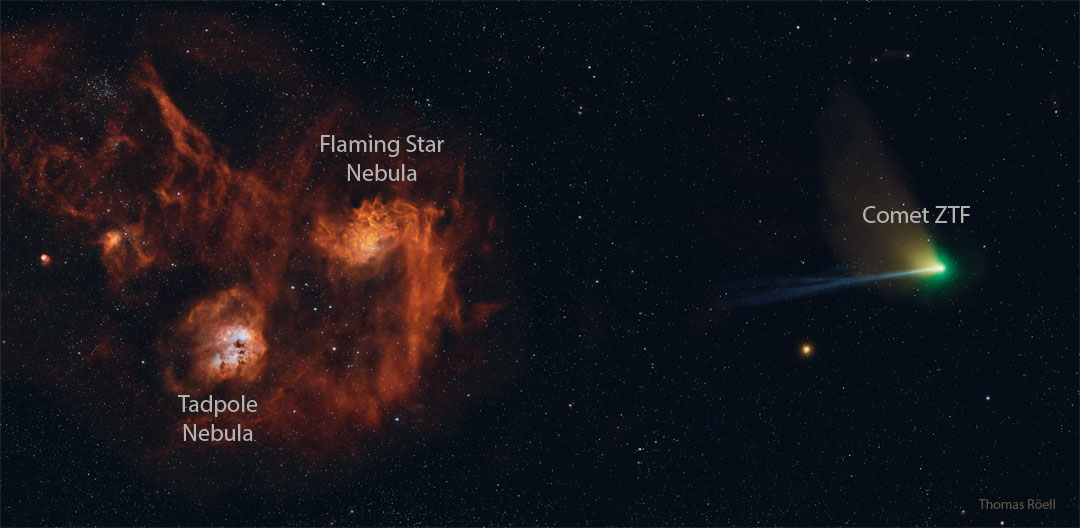Today's APOD uses the same caption that was used for
the APOD of March 26, 2019. But the APOD of March 26, 2019 was really a closeup portrait of AE Aurigae and the Flaming Star Nebula, whereas today's APOD is a composite showing us other important deep-sky objects too. Still,today’s caption refers only to the Flaming Star Nebula and AE Aurigae.
There are definitely things that I admire about today's APOD. Most of all, I admire the portrait of the comet, the green and brilliantly white coma, the broad sweeping yellow dust tail and the narrow blue bifurcated IOM tail. Bravo!
I'm a lot less enthusiastic about the portrait of the nebulas at left. First of all, the portrait of them was made using narrowband photography, which I'm normally not too happy about (since I usually don't find such images very aesthetically pleasing or "true" color). Okay, so how can we tell that the portrait of the nebulas was made using narrowband filters?
In the broadband image by Keesscherer at left, you can see how the the blue light of star AE Aurigae reflects off dust in the in the Flaming Star Nebula, making the dust shine softly blue. (The rest of the Flaming Star Nebula is red from the glow of ionized hydrogen). The Tadpole Nebula, by contrast, looks non-blue in the broadband image.
But in the narrowband image by u/amajed172 (Anas Almajed), the blue color disappears from the Flame Nebula, but it appears in the Tadpole Nebula instead. The Tadpole Nebula is a site of star formation, unlike the Flaming Star Nebula, which is just a gas cloud being lit up by a passing star, O9.5V-type AE Aurigae. And while AE Aurigae is hot, certainly hot enough to ionize hydrogen and make it glow red, that's nothing compared with HD 242908, the main ionizing star of the Tadpole Nebula. HD 242908 is spectral class O4.5V, and
that's hot! Therefore, there is a lot of ionized oxygen in the Tadpole Nebula, which is detected by OIII filters and mapped as blue in narrowband images.
(Also, fascinatingly, the Flaming Star Nebula is "only" some 1,300 light-years away, while the Tadpole Nebula resides at a whopping distance of some 11,000 light-years. Wowzers! That's also why the Tadpole Nebula is more dust-reddened than the Flaming Star Nebula and looks more orange than the Flaming Star Nebula, which looks a bit more magenta.)
In today's APOD, you can see that the inner part of the Tadpole Nebula is blue, whereas the Flaming Star Nebula is non-blue. This is a dead giveaway that these nebulas have been photographed using narrowband filters. (Admittedly, if you look at the full size of today's APOD, which I highly recommend, you can actually make out the bluish dust lanes of the Flaming Star Nebula, where they are a faint shade of gray.)
Okay, here's my main complaint. Today's APOD is a composite where the right side of the image was made using broadband photography (the comet) and the left side was made primarily using narrowband filters (the nebulas). This makes my head spin a little.
But do note the lovely cluster, M38, in the upper left corner of the APOD! This sure looks like a broadband portrait of the cluster.
Ann
 The Flaming Star Nebula
The Flaming Star Nebula



